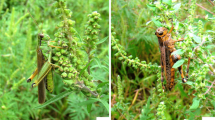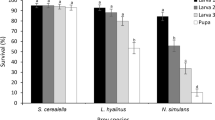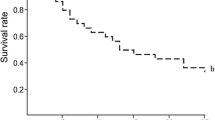Abstract
Larvae ofUresiphita reversalis (Guenée) (Lepidoptera: Pyralidae) sequester quinolizidine alkaloids from their leguminous hosts and store them primarily in the cuticle. Stored alkaloids are lost with the last larval molt. Extracts of late-instar larvae and of pupae were applied to larvae of the potato tuber moth,Phthorimaea operculella (Zeller) (Gelichiidae), which are normally palatable to two hymenopteran predators, the Argentine ant,Iridomyrmex humilis (Mayr) (Formicidae), and the paper wasp,Mischocyttarus flavitarsus (Sauss.) (Vespidae). Larvae ofP. operculella treated with alkaloid extracts ofU. reversalis larval exuviae, or with surface extracts of whole larvae, were deterrent to both predators, compared to untreated prey. Extracts of pupal exuviae added toP. operculella, however, were not deterrent.P. operculella larvae treated with the authentic alkaloids sparteine and cytisine were also deterrent to these hymenopteran predators. Storage of small but concentrated amounts of plant secondary compounds in the cuticle appears to be an efficacious means of defense against at least two common predators of lepidopteran larvae.
Similar content being viewed by others
References
Berenbaum, M. R., andMiliczky, E., 1984. Mantids and milkweed bugs: efficacy of aposematic coloration against invertebrate predators.Am. Midi. Nat. 111:64–68.
Bernays, E. A. 1988. Host specificity in phytophagous insects: Selection pressure from generalist predators.Entomol. Exp. Appl. 49:131–140.
Bernays, E. A., andCornelius, M. L. 1989. Relative acceptability of caterpillars with different host range to the generalist predatorIridomyrmex humilis.Oecologia 79:427–430.
Bernays, E. A., andMontllor, C. B. 1989. Aposematism ofUresiphita reversalis larvae (Pyralidae).J. Lep. Soc. 43:261–273.
Blum, M. S. 1981. Chemical Defenses of Arthropods. Academic Press, New York. 562 pp.
Boppré, M. 1990. Lepidoptera and pyrrolizidine alkaloids.J. Chem. Ecol. 16:165–186.
Bowers, M. D., andLarin, Z. 1989. Acquired chemical defense in the lycaenid butterfly,Elimaeus atala.J. Chem. Ecol. 15:1133–1146.
Brattsten, L. B. 1986. Fate of ingested plant allelochemicals in herbivorous insects, pp. 211–255,in L. B. Brattsten and S. Ahmad (eds.). Molecular Aspects of Insect-Plant Associations. Plenum Press, New York.
Brower, L. P. 1984. Chemical defense in butterflies, pp. 109–133,in R. I. Vane-Wright and P. R. Ackery (eds.). The Biology of Butterflies. Symposium of the Royal Entomological Society, London, Vol. VII. Princeton University Press, Princeton, New Jersey.
Dempster, J. P. 1984. The natural enemies of butterflies, pp. 97–104,in R. I. Vane-Wright and P. R. Ackery (eds.). The Biology of Butterflies. Symposium of the Royal Entomological Society, London, Vol. VII. Princeton University Press, Princeton, New Jersey.
Egelhaaf, A., Cöllin, K., Schmitz, B., Buck, M., Wink, M., andSchneider, D. 1990. Organ specific storage of dietary pyrrolizidine alkaloids.Z. Naturforsch. 45c: 115–120.
Feeny, P., Blau, W. S., andKareiva, P. M. 1985. Larval growth and survivorship of the black swallowtail butterfly in central New York.Ecol. Monogr. 52:167–187.
Franzl, S., Naumann, C. M., andNahrstedt, A. 1988. Cyanoglycoside storing cuticle ofZygaena larvae.Zoomorphology 108:183–190.
Gould, W. P., andJeanne, R. L. 1984.Polistes wasps (Hymenoptera: Vespidae) as control agents for lepidopteran cabbage pests.Environ. Entomol. 13:150–156.
Jones, D. A., Parsons, J., andRothschild, M. 1962. Released hydrocyanic acid from crushed tissues of all stages of the life cycle of species of Zygaeninae (Lepidoptera).Nature 193:52–53.
Jones, R. E., 1987. Ants, parasitoids, and the cabbage butterflyPieris rapae.J. Anim. Ecol. 56:739–749.
Kelly, R. B., Seiber, J. N., Jones, D. D., Segall, H. J., andBrower, L. P. 1987. Pyrrolizidine alkaloids in overwintering monarch butterflies (Danaus plexippus) from Mexico.Experientia 43:943–946.
Laine, K. J., andNiemela, P. 1980. The influence of ants on the survival of mountain birches during anOporinia autumnata (Lep., Geometridae) outbreak.Oecologia 47:39–42.
Montllor, C. B., Bernays, E. A., andBarbehenn, R. V. 1990. Importance of quinolizidine alkaloids in the relationship between larvae ofUresiphita reversalis (Lepidoptera: Pyraiidae) and a host plant,Genista monspessulana.J. Chem. Ecol. 16:1853–1865.
Nahrstedt, A., andDavis, R. H. 1983. Occurence, variation and biosynthesis of the cyanogenic glycosides linamarin and lotuaustralin in species of the Heliconini (Insecta: Lepidoptera).Comp. Biochem. Physiol. 758:65–73.
Risch, S. J., andCarroll, C. R. 1982. Effect of a keystone predaceous ant,Solenopsis geminata, on arthropods in a tropical agroecosystem.Ecology 63:1979–1983.
Rothschild, M., Rowan, M. G., andFairbairn, J. W. 1977. Storage of cannabinoids byArctia caja andZonocerus elegans fed on chemically distinct strains ofCannabis sativa.Nature 266:650–651.
Rothchild, M., Aplin, R. T., Cockrum, P. A., Edgar, J. A., Fairweather, P. andLees, R. 1979. Pyrrolizidine alkaloids in arctiid moths (Lep.) with a discussion on host plant relationships and the role of these secondary plant substances in the Arctiidae.Biol. J. Linn. Soc. 12:305–326.
Shaw, P. B., Owens, J. C., Huddleston, E. W., andRichman, D. B. 1987. Role of arthropod predators in mortality of early instars of the range caterpillar,Hemileuca oliviae (Lepidoptera: Saturniidae).Environ. Entomol. 16:814–820.
Skinner, G. J., andWhittaker, J. B. 1981. An experimental investigation of interrelationships between the wood-ant (Formica rufa) and some tree-canopy herbivores.J. Anim. Ecol. 50:313–326.
Stamp, N. E., andBowers, M. D. 1988. Direct and indirect effects of predatory wasps (Polistes sp.: Vespidae) on gregarious caterpillars (Hemileuca lucina: Saturniidae).Oecologia 75:619–624.
Steward, V. B., Smith, K. G., andStephen, F. M. 1988. Predation by wasps on lepidopteran larvae in an Ozark forest canopy.Ecol. Entomol. 13:81–86.
vonNickisch-Rosenegk, E., Detzel, A., Wink, M., andSchneider, D. 1990a. Carrier-mediated uptake of digoxin by larvae of the cardenolide sequestering moth,Syntomeida epilais.Naturwissenchaften 77:336–338.
vonNickisch-Rosenegk, E., Scheider, D., andWink, M. 1990b. Time-course of pyrrolizidine alkaloid processing in the alkaloid exploiting arctiid moth,Creatonotos transiens.Z. Naturforsch. 45c:881–894.
Watt, A. D. 1989. The growth and survival ofPanolis flammea larvae in the absence of predators on Scots pine and lodgepole pine.Ecol. Entomol. 14:225–234.
Weseloh, R. M. 1989. Simulation of predation by ants based on direct observations of attacks on gypsy moth larvae.Can. Entomol. 121:1069–1076.
Wink, M., andSchneider, D. 1988. Carrier-mediated uptake of pyrrolizidine alkaloids in larvae of the aposematic and alkaloid-exploiting mothCreatonotos. Naturwissenschaften 75:524–525.
Witz, B. W. 1990. Antipredator mechanisms in arthropods: a twenty-year literature survey.Fl. Entomol. 73:71–99.
Author information
Authors and Affiliations
Rights and permissions
About this article
Cite this article
Montllor, C.B., Bernays, E.A. & Cornelius, M.L. Responses of two hymenopteran predators to surface Chemistry of their prey: Significance for an alkaloid-sequestering caterpillar. J Chem Ecol 17, 391–399 (1991). https://doi.org/10.1007/BF00994340
Received:
Accepted:
Issue Date:
DOI: https://doi.org/10.1007/BF00994340




